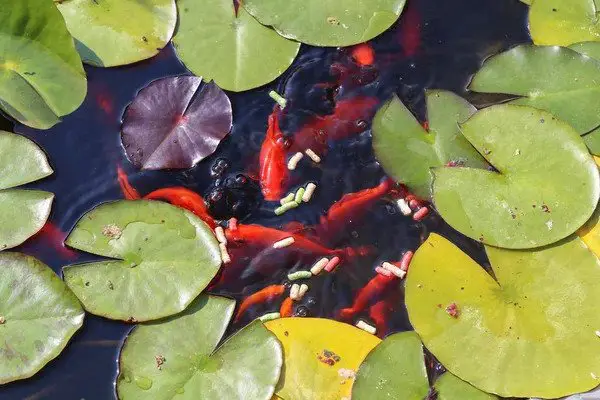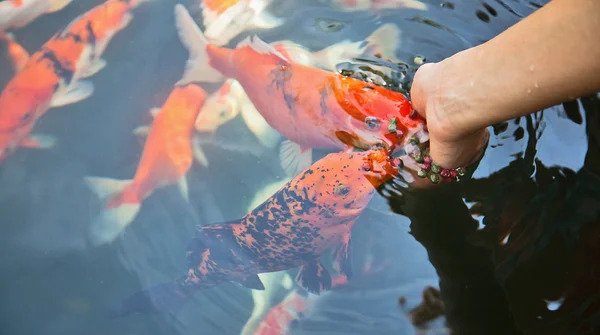Keeping goldfish in the aquarium or a controlled indoor pond differs from keeping goldfish in an outdoor pond. In the aquarium, goldfish browse aquarium plants for food in addition to the fish food provided by their owner.
But the same is not the case for goldfish in an outdoor pond.
If you have a pond in your backyard and are wondering what pond goldfish thrive on, check out this article to understand what your fish need.
What Do Pond Fish Eat? (Feeding Goldfish)

Although there are some things you can do to control the conditions of the fish pond to an extent, the pond can be likened to the wild habitats of goldfish.
Pond goldfish will eat what they can find in the pond, and they eat a balanced diet most of the time, consisting of aquatic plants and animal matter. Plants they nibble on when hungry include aquatic plants like green algae, water sprite, duckweed, etc.
Pond goldfish also enjoy a very rich meat-based diet. Some of the meat-based foods pond goldfish thrive on in the wild include small crustaceans like zooplankton and worms found on the bottom of the pond.
Outdoor goldfish also enjoy insects that rest or lay eggs on the water surface, insect larvae, and the larvae of amphibians, such as tadpoles.
They also eat caecilians, fish eggs, fish fry, and even smaller fish. The list is almost endless as they can eat anything small enough to fit into their mouth, depending on what is available in the pond.
Interestingly, goldfish are generally bad parents. Do not be surprised when you see your pond goldfish eat their fry.
In an artificial pond, the pond owners usually add some supplemental food items to the pond. These supplemental foods are mostly high-protein pellet foods and goldfish flakes. But they may also include live food like brine shrimp and plant-based commercial food like goldfish flakes to supplement the goldfish pond food.
Some other goldfish foods you can use as pond food include green vegetables like kale, beet tops, zucchini, shelled peas, and cabbage. But if you choose to supplement, you want to ensure that you remove uneaten food to prevent them from ruining the water parameters and quality.
You can also feed sinking pellets, especially if concerned about water quality. Sinking pellets will break down slowly without negatively affecting the water quality.
Feeding Frequency for Pond Goldfish

How many times you feed your goldfish is as important as what you feed them. Goldfish in a controlled environment like a freshwater aquarium or an indoor pond need to be fed.
If you are not keeping goldfish in the aquarium, or any other controlled environment, there is hardly any reason to worry much about feeding frequency.
In outdoor ponds, goldfish feed on decaying animal matter and plants whenever they please. As bottom feeders, they usually forage underwater for aquatic plant matter like green algae.
They also eat decaying remains of animals and other natural fish food they find in the pond water.
Feeding your goldfish about 1-2 times daily would be best when the temperature is warmer during spring and summer. But you will have to increase the frequency to about 5 times a day as the temperature reaches its peak.
Although pond fish like the koi goldfish can fend for themselves in an outdoor pond, they also need to eat more often during the warmer months.
You want to give your pond goldfish only what it can finish in about 3-5 minutes. After that, you must take out the uneaten food from the water to retain the water quality.
How To Feed Pond Goldfish During Winter

Feeding goldfish during winter is pretty different from when you feed them during warmer temperatures. Since water temperatures are constantly regulated in an aquarium, you must give your goldfish food throughout the year.
But in an outdoor setup like a goldfish pond, the choice to feed your goldfish some fish meal or freeze-dried brine shrimp will depend on the prevailing temperature.
So how much fish food you offer your pet in the pond and how often you offer them food will depend on the water temperature.
You need to offer your pond goldfish more fish food during the warmer months of spring and summer.
Although they get their natural fish food from the pond water, you can ensure they have enough food by adding pellet food, flake foods, or some live food to the pond. It would be best to provide fish food about three times a week.
You can also offer your goldfish some vegetables and fruits to ensure a balanced diet.
But as the months get colder, you want to reduce the feeding frequency and the quantity of goldfish food that you feed goldfish in the pond. You also want to reduce how much protein you let your pond goldfish eat.
You must pay attention to the temperature of the pond water. Fish metabolism slows down in water temperatures below 50°F. At this temperature and below, goldfish normally become lethargic and will not require any food.
During the winter months, goldfish will enter winter hibernation. You will need to stop feeding goldfish altogether during the winter months as they cannot break down food.
But you can start feeding them again after the temperature rises above 50°F. Start slowly with small quantities once they have started feeding again.
How To Feed Baby Goldfish in a Pond

Feeding baby goldfish is vital because goldfish are bad parents. They literally eat anything that is small enough to fit into their mouth, and baby goldfish are no exception.
This means the baby goldfish are always a few seconds away from becoming goldfish food.
One of the ways to prevent this is to feed baby goldfish food that can help them grow big enough not to fit into the mouth of an adult fish.
You need to provide your baby goldfish with a high-protein diet to help them grow into adult fish. They need no less than about 40% protein in their first 12 months.
It would be best to start your baby goldfish with baby brine shrimp in the first few days of their lives. You can also feed them infusoria. These are usually better alternatives to commercial baby fish food.
After about seven days, you can introduce commercial fish food. Pellet food is a good choice because it comes in varieties. You have the floating and sinking pellets. You can also feed them goldfish flakes, but they are usually higher in plant matter, so they will hardly offer as much protein as pellets which are made from fish meal.
It is important that you grind the pellets into small pellets before feeding your baby goldfish. Remember that, unlike adult fish, they are yet to grow big mouths like larger goldfish.
Final Thoughts

Goldfish can normally live up to decades if provided with the right living conditions. An outdoor pond is an ideal place to keep goldfish. But without the right knowledge about pond goldfish diet, you cannot help your goldfish enjoy a fulfilling life.
Pond goldfish diet is important because it helps you know what your goldfish should eat, how often, and when not to feed them.
Since pond fish normally have a natural food source, failing to understand this can lead to overfeeding your fish and making them obese. All these and many more make it very important to understand pond goldfish diet.

